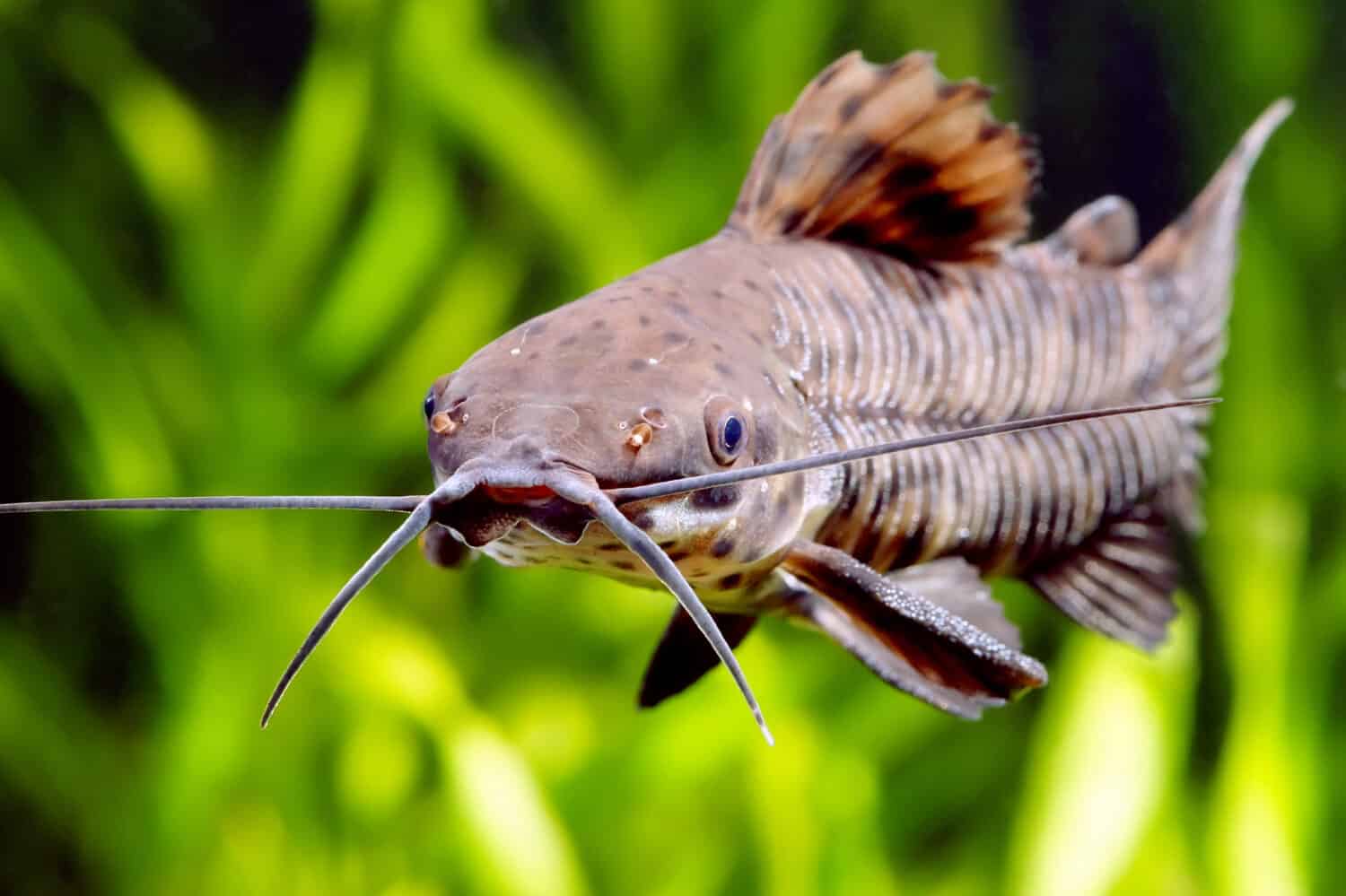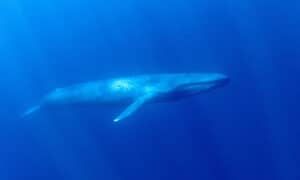It is only natural to think of animal battles happening on the plains of Africa between a lion and a hyena, a crocodile and a wildebeest, or between a pack of wild dogs and a warthog. However, the deep sea battles are the ones that aren’t often talked about.
When we read the title of the giant squid, we were all probably thinking we would name a specific giant squid. However, oddly enough, the giant squid is the name of the giant squid we refer to. If that isn’t an oxymoron, we don’t know what is.
Now we turn to the largest electric eel, which happens to be a species of the electric eel, the Electrophorus voltai, commonly referred to as just E. voltai.
Now, before determining who will win in this deep-sea battle, we must understand a few foundational traits of both these animals.
- Physical characteristics
- Diet
- Habitat
- Predators
Electrophorus Voltai Facts

The Electrophorus voltai is named after the physicist Alessandro Volta. Who is the one attributed to creating the electric battery.
©C. David de Santana, William G. R. Crampton, Casey B. Dillman, Renata G. Frederico, Mark H. Sabaj, Raphaël Covain, Jonathan Ready, Jansen Zuanon, Renildo R. de Oliveira, Raimundo N. Mendes-Júnior, Douglas A. Bastos, Tulio F. Teixeira, Jan Mol, Willian Ohara, Natália Castro e Castro, Luiz A. Peixoto, Cleusa Nagamachi, Leandro Sousa, Luciano F. A. Montag, Frank Ribeiro, Joseph C. Waddell, Nivaldo M. Piorsky, Richard P. Vari & Wolmar B. Wosiacki, CC BY 4.0 – License
The world, both land, and sea, is filled with hundreds of thousands of species of animals. Combine the two together, and we get millions of species alone.
While it is impossible to say emphatically how many species there are, as new ones are being discovered yearly, there are estimated to be some 8,750,000 species worldwide.
When we look at the electric eel, it can be easy to assume that that is all-encompassing. Some animals have thousands; however, lucky for us, there are only three species of electric eel. The three species are the following.
- The electric eel (Electrophorus electricus)
- Vari’s electric eel (Electrophorus varii)
- Volta’s electric eel (Electrophorus voltai)
Having similar traits in physicality, diet, habitat, and predator status, it can be easy to confuse the E. voltai. However, upon taking a closer look, we can find some differences. Let’s start with the physical characteristics.
Physical Characteristics of the Electrophorus Voltai
In physicality, electric eels often look very similar. But, as the largest of the electric eels, the E. voltai, we can see some stark differences in length and the construction of their heads.
The E. voltai can grow up to eight feet long. They also have flat and wider heads compared to the other two species of electric eels.
Perhaps the most distinguishing and terrifying aspect of the E. voltai is its ability to discharge 860 volts. To put this into comparison, the main species we are most familiar with, the E. electricus, emits 480 volts (almost half of what the E. voltai is capable of.)
And the E. varii produces 572 volts. Which still, in contrast, is nothing short of incredible to see how many volts the E. voltai can put out.
With the electric eel’s size in mind, let’s go deeper to find out what diet they keep up.
Diet of the Electrophorus Voltai

The Megalechis thoracata is a species of fish, and it’s common name is the Hoplo
Catfish
.
©Grigorev Mikhail/Shutterstock.com
Electric eels are carnivores, and because of this prefer to stick to their seafood variety. Their diet consists of fish, insects, and small vertebrates.
Amongst these, they also like eating crustaceans. In younger years, they would also eat crabs and shrimp.
A scientific study published by the National Library of Medicine (PubMed) stated that when the E. voltai was captured, the “analysis of their stomach contents revealed that fish, especially Megalechis thoracata, were the most frequent prey item.”
Let’s look now at where the E. voltai resides to keep up with this varied diet.
Habitat of the Electrophorus Voltai
Electric eels often reside in murky waters, which can be found in freshwater areas like South America. They can also usually be found in the Amazon and Orinoco river basins.
It’s interesting to note that no matter where we find these electric eels, they can breathe in and out of water.
Due to the nature of the confines of where electric eels can be found, let’s see if that changes how many predators the E. voltai has.
Predators of the Electrophorus Voltai

Although not tasty due to their bony nature, humans can eat electric eels.
©Mamsizz/Shutterstock.com
Predators can be categorized as one animal who preys (hunts, kills, and eats) upon another. As with the rule of thumb of survival of the fittest, the same can be true of the animal kingdom.
A Journal of Theoretical Biology published states that as a predator looking for prey, “It implicitly takes into account the ease or difficulty of capture of the various prey species available to the predator.”
In easier terms, animals know what they can and cannot hunt. A warthog wouldn’t try to take down an elephant. And a hyena isn’t going to try to take down a hippopotamus.
The E. voltai shockingly, pun absolutely intended, has no known predators. This is not surprising due to their voltage status. The only thing threatening their survival is humans.
Now that we’ve built a foundation of the Electrophorus voltai, as the largest electric eel, let’s turn our focus to the giant squid.
Giant Squid (Architeuthis dux) Facts

A giant squid reaching lengths of 60 feet can be compared to that of a semi truck and trailer.
©Shiva N hegde/Shutterstock.com
As we stated at the beginning of this article, the giant squid was named just for that reason because it is a giant. What’s interesting to note is that our information on the giant squid is minimal.
What is known about the giant squid is garnered from scientific studies and research. If you do a quick Google search, the first several websites that come up, you will see varying information regarding their weight, length, and other known facts.
A study by Clyde F.E. Roper and Kenneth J. Boss that was published in a scientific journal completed a thorough study of the giant squid.
In this study, they start by comparing the giant squid to the findings in the Moby-Dick book by Herman Melville.
“Vast pulpy mass, furlongs in length …. Long arms radiating from its center and curling and twisting like a nest of anacondas.”
Roper and Boss took this to mean that Herman Melville directly referred to the giant squid. They say it is amazing to think that what was considered mythical was scientifically proven truthful when in 1861, a giant squid was actually discovered.
Let’s take a sea dive down to the deep ocean and discover what we know about the giant squid.
Physical Characteristics of the Giant Squid
There are varying opinions, as we said, about the physical characteristics of the giant squid. It is assumed that the giant squid weighs as much as 300-600 pounds, reaches lengths of 40-50 feet long, and heights of 5-7 feet tall.
In that same breath, other studies, like the one we shared above from Roper and Boss, say that some giant squid has reached as much as 1,000 pounds and lengths of 60 feet with their tentacles fully extended.
Let’s look at what keeps these giant squid fed daily to keep up this enormous weight.
Diet of the Giant Squid

The orange roughy is approximately 15 pounds, and can reach lengths of 30 inches.
©Brendan Lin/Shutterstock.com
Giant squid are like other squid, with eight arms and two long tentacles called feeding tentacles. They have a sharp beak in the middle of their arms that they use to slice their prey open so they can take smaller bites.
The giant squid will often be preying on fish, shrimp, and other squid. One of their luxuries to eat is deep-sea fish, like the orange roughy (Hoplostethus atlanticus).
Because of the fact that these giant squid will feast on deep-sea fish, let’s take a look at where their habitat resides in the ocean.
Habitat of the Giant Squid
Like the aforementioned section, giant squid can be found in the deep recess of the Earth’s waters. This is partially why so little information can be found on these enormous sea creatures. After all, it’s not like you can just go to your local zoo and see a giant squid.
Typically in subtropical marine waters is where we can find giant squids. Down in the black, freezing depths, about 1,650 feet (500 meters) to 3,300 feet (1,000 meters) beneath the ocean’s surface.
It is also researched that giant squids can be found in all of the world’s oceans. Especially in Newfoundland, Norway, the northern British Isles, Spain, and the southwestern Pacific, to name a few.
Because of the depths, this giant squid can be found in, their predators are easier to pinpoint. Let’s take a look.
Predators of the Giant Squid

Killer whales weigh up to 15,000 pounds and can swim up to 30 miles per hour.
©qingqing/Shutterstock.com
Those animals who frequent the depths of the ocean’s waters prey on this enormous giant squid.
Predators such as sperm whales, pilot whales, southern sleeper sharks, and even in some places, killer whales, more commonly referred to as orcas.
Now that we have looked deeply into the Electrophorus voltai and the giant squid let’s finally answer that question we have been itching to know this whole time.
Can the World’s Largest Electric Eel Take Down a Giant Squid?

When researching great battles between animals, we have to study all their aspects first before making an educated guess on who would come out on top.
©ImYanis/Shutterstock.com
It’s always fun to look at animals and wonder who could take who down in a fight, like a bull vs. an adult lion, a king cobra vs. a wolf, or a grizzly bear vs. a jaguar. These topics carry one exciting factor: the mystery of who would come out on top.
And as we see in many cases in the animal kingdom, the underdog can often surprise us. And also, just because it is the bigger animal doesn’t mean it will always come out on top. There are so many factors to consider.
We’ve laid a solid foundation for the giant squid and the E. voltai, looking at their physical traits, diet, habitat, and predator status. When we look at all these things, we’ve determined that the E. voltai would come out the winner in this fight.
We know the first thing coming to most people’s minds right now is that the giant squid can literally grow to 60 feet long in some cases! And you’d be right. However, an animal that can release 860 volts is not something to take lightly.
Let’s make a quick comparison. It would take approximately 100-250 volts to kill a human being. Even with this large number, death has been recorded at as low as 42 volts.
At 860 volts, we are sure that this could not only severely injure a giant squid, but it could also lethally end its life too.
After all of that, we would also have to agree that the giant squid would put up one big fight and would not go down easy.
The photo featured at the top of this post is © iStock.com/3dsam79
Thank you for reading! Have some feedback for us? Contact the AZ Animals editorial team.






